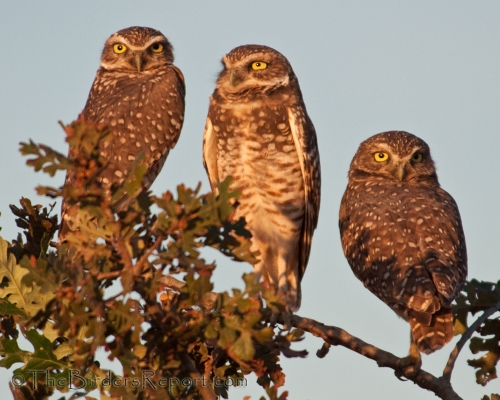 Burrowing Owls At Sunset photos by Larry Jordan
Burrowing Owls At Sunset photos by Larry Jordan
I recently got back from a meeting of the Burrowing Owl Consortium that was held in Mountain View, California. The meeting was hosted by Catherine Portman of the Burrowing Owl Preservation Society and several friends. There were several studies presented on different aspects of California Burrowing Owl habitat, location, diet and population dynamics.
A few of the presenters were Jack Barclay, a senior wildlife biologist with Albion Environmental, Phil Higgins, a biology instructor at De Anza College in Cupertino and keeper of the Burrowing Owls at Shoreline Park where the meeting was held, and Bob Wilkerson a biologist with the Institute of Bird Populations located in Point Reyes Station. Bob has just finished a population study of Burrowing Owls in California and I await his final report available in November. In the meantime…
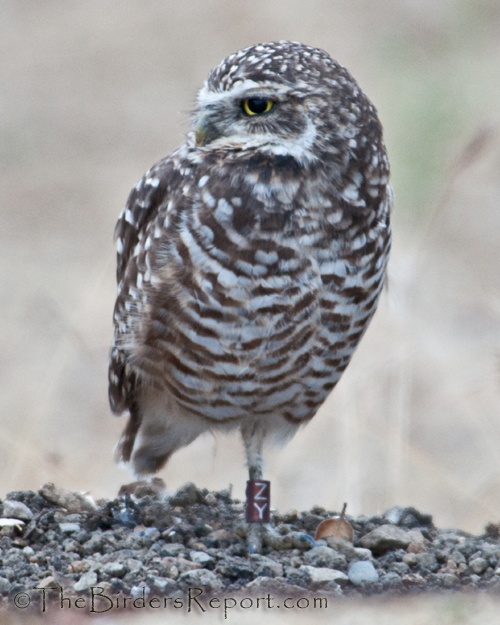
Bob Power, Executive Director of the Santa Clara Valley Audubon Society lead some of us early birds on a Burrowing Owl tour of Mission College (where we saw several owls on campus including the one pictured above) and Shoreline Park where we met up with Phil Higgins. Joyce Bender was one of the people I met on this morning tour before the meeting. She is the lady who designed and helped install the artificial burrows at Wildhorse Golf Club in Davis, along with Catherine Portman, Jim Rose, the grounds keeper, and local school children. The remaining images of Burrowing Owls and the artificial habitat were taken there.
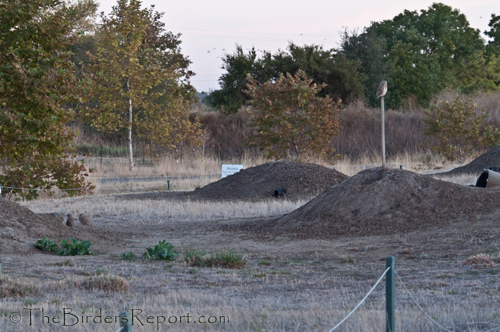
This is a section of artificial Burrowing Owl habitat in Davis. You can see two owls near one of the entrances on the left and one perched on a stake above one of the mounds. The sign, barely visible in the background reads “Attention: Burrowing Owl Habitat, Proceed with Care, NO CARTS.” The rope in the foreground separates the habitat from the golf course where I am standing. The golf cart path is about eight feet from this rope and the owls watch them go by, unimpressed.
If disturbed, the owls will fly, low to the ground, to a burrow entrance and re-access the situation. The carpet covered plastic serves as a foyer for the young when they emerge from the burrow to help protect them from hawks and other avian predators.
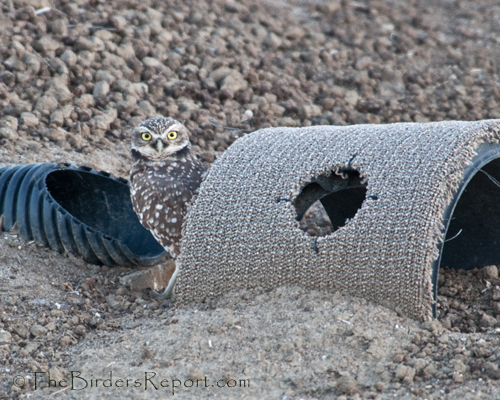
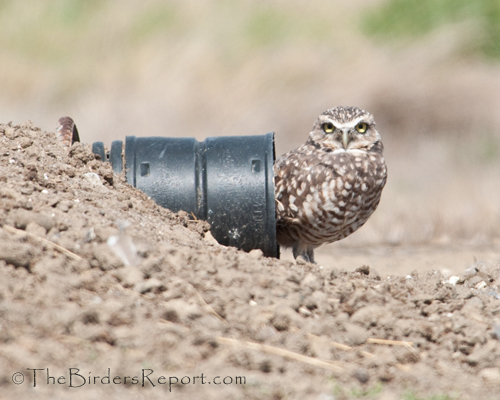
I arrived this day at Wildhorse Golf Club as the sun was beginning to set and the owls were very active. As I approached the artificial habitat area, several owls moved to new locations. Three flew up into a nearby oak tree and surveyed their surroundings as joggers ran by on the path behind them, directly opposite the golf cart path, giving me great views of their many different “looks.” The little guy on the right, which appears to be a juvenile (incomplete eyebrow) is doing the reverse head tilt (with its back to us), I think, questioning why I am still standing there.
With the sun sinking quickly behind the California Coastal Mountains, this Burrowing Owl stood in front of its burrow entrance watching as I reluctantly headed back home.
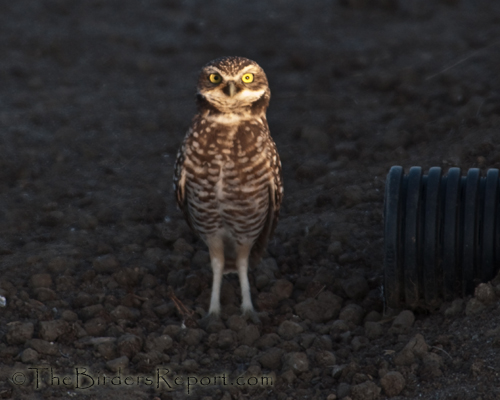

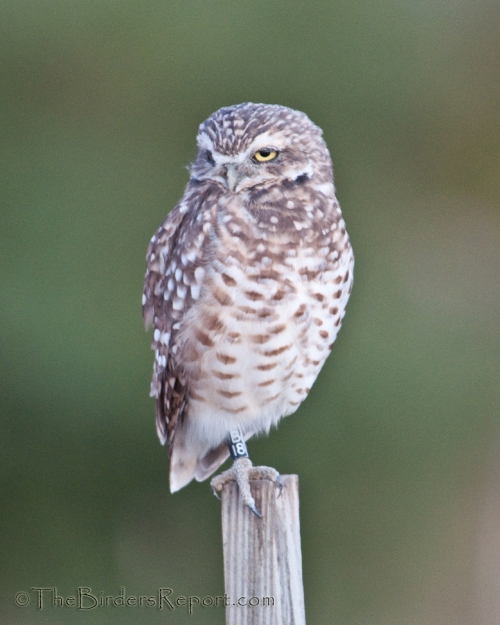
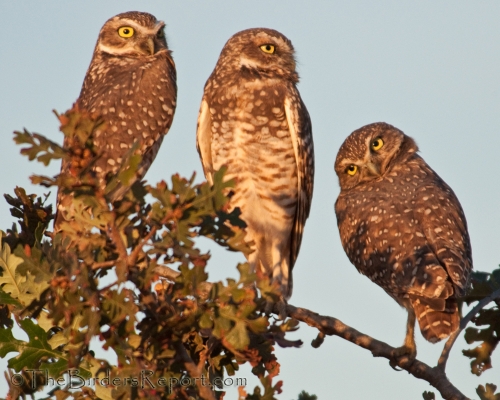








Comments on this entry are closed.
Interesting. However – I’m not really keen to see these plastic structures, carpet etc.
If they are to re-establish a population, then it has to happen with natural means – and the Owls do not have these “devices” if they are to nest in a different location. That is taken conservation efforts too far – and isn’t really helpful in the long run.
@Klaus I understand your concern. As I stated in an earlier post, there are more owls living in natural burrows at this location than there are in this artificial burrow site.
Most of the successful Burrowing Owl populations in California occur where there are a sufficient number of burrowing animals to dig the burrows, namely ground squirrels.
This site is teaming with ground squirrels and the owls live with them, side by side. I feel that where there is good habitat for owls, in locations where they may have been pushed out of for one reason or another (ie, squirrel poisoning), if the artificial burrows can give them a healthy start, they may return to live in these once hospitable locations via natural means.
I’m glad to hear that there are some efforts going on to help these little guys out. They have been pushed out of Boulder County, CO where I used to live and bird quite a bit.
.-= Steve B´s last blog ..Migrating Peeps =-.
Larry, I love this. That last photo is a classic. And I’m beside myself with the thought that of a whole symposium devoted to burrowing owls. Seventh heaven!
.-= Wren´s last blog ..My World: Brisbane Skyline from Mt Cootha =-.
@Steve it is sad to see a species as cute as these guys get “pushed out” but that is what’s happening all over California
@Wren thanks. I hope we can make a difference with the Burrowing Owl in northern California before it’s too late. BTW, I love your new header and look of your blog!
Such an interesting post and definitely hopeful for the future of these interesting birds. I agree that it is best to have them in totally wild surroundings (no carpet and plastics!) but if the other options is no owls at all then there’s no question in my mind that this is a very worthwhile project. Hope it succeeds and they eventually populate totally wild areas.
.-= Mick´s last blog ..Ospreys =-.
@Mick I couldn’t agree more. Thanks for the comment
Love that last foto!
.-= Ambika´s last blog ..Reading, learning, birding, blogging – I and the Bird #109 =-.
@Ambika thank you very much. I really enjoyed your edition of IATB #109!
Great photographs, along with a great story. Humans have left them with no choice but to live with human waste!
.-= rocksea´s last blog ..time for an elephant bath =-.
Thanks, Larry, for another informative discussion on the Burrowing Owls, not to mention the excellent photographs!
I’m just wondering…any chance these owls might be hit by a stray golf ball?
.-= bob k´s last blog ..The Jay that Saved My Day =-.
Hi Larry,
Wow It looks like a very endangered species that we try to take care off! let’s hope this program and artificial burrows will work!! I’m happy to discover this species through your blog, because I did not know it and it is nice to have so much info!
Your shots are fantastic and reveal the beauty of the bird! Well done!
.-= chris´s last blog ..Nice week end! =-.
My feeling is that we humans have taken away so much habitat that we owe it to struggling populations to help them out. Living on a golf course isn’t natural so it doesn’t matter if the materials aren’t natural. Some people take issue with rehabbers as ‘nature’ should take its course. Very few areas of the planet are natural anymore and we owe it to help the wildlife.. Michelle
Hi Larry and Klaus,
Regarding natural vs. artificial materials for burrows, I believe this question was also posed at the Burrowing Owl Consortium and the answer, if I remember correctly, was that there was no correlation observed between owlets reared in artificial burrows and their preference for choosing future burrows.
However, I don’t have any stats or reports…simply thought I’d throw it out since the topic came up.
And thanks for sharing as I will just have to schedule a work appointment in Davis and stop by Wild Horse Golf Club.
.-= Scott´s last blog ..We The People…of conservation =-.
I think that using artificial burrows is actually really interesting idea and if it helps reestablish a population such as this, I am all in favor.